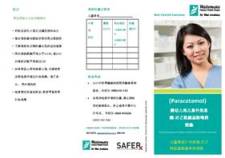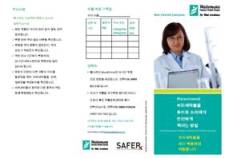Safe Use Of Paracetamol In Children
Safe Use Of Paracetamol In Children
Paracetamol is a medicine to help reduce pain. Too much paracetamol can harm your child. Always measure doses exactly and check the strength - there are different strengths. There have also been recent changes in the funded brands of paracetamol.
Important notice about paracetamol changes
The funded brands of paracetamol have changed.
Paracetamol 250 mg in 5 mL
From 1 November 2022, Paracare paracetamol liquid 250 mg in 5 mL has been replaced by a new brand called Pamol.
Find out more about the brand change (from Pharmac - Te Pātaka Whaioranga leaflets):
- English (PDF, 220KB)
- Te reo Māori (PDF, 302KB)
- Samoan (PDF, 270KB)
- Tongan (PDF, 306KB)
- Chinese (simplified) (PDF, 514KB)
Paracetamol 120 mg in 5mL
From January 2023, a new brand of paracetamol liquid 120 mg in 5 mL has been available. Ethics paracetamol has replaced the Paracare and Avallon paracetamol liquid brands.
Find out more about the brand change (from Pharmac - Te Pātaka Whaioranga leaflets):
- English (PDF, 81KB)
- Te reo Māori (PDF, 289KB)
- Samoan (PDF, 261KB)
- Tongan (PDF, 301KB)
- Chinese (simplified) (PDF, 493KB)
Always give the right dose
Always read the label and give your child the right dose based on your child's weight and the strength of paracetamol.
Key points about the safe use of paracetamol in children
- paracetamol is a medicine to help reduce pain
- your child doesn't need it for fever alone - if your child is miserable because of the fever, you can give paracetamol to make them more comfortable
- too much paracetamol can be dangerous
- keep all medicines out of reach of children, in a locked or latched cupboard
- before each dose, check if your child still needs it
- know the right dose to give and check the strength
- give no more than 4 times in 24 hours
- if someone else has been caring for your child, ask if they gave your child paracetamol, how much and when
- check other medicines your child is taking - they may have paracetamol in them
Always measure doses exactly. Ask your pharmacist or nurse for an oral syringe - to give your child medicine by mouth.
What is paracetamol?
- paracetamol is a medicine to help reduce pain
- paracetamol is the name of the medicine but it has many brand names including Pamol, Avallon, Paracare and Panadol
- it will not cause drowsiness or cause your child to sleep
Does my child need paracetamol?
You can use paracetamol for children and babies over 3 months old - younger babies must see the doctor.
- you can use it for children and babies over 3 months old
- younger babies must see the doctor
- only give paracetamol if it's necessary
- fever is a normal response to infection and is not in itself harmful, so you don't need to give paracetamol for fever alone
- if your child is miserable because of the fever, you can give paracetamol to make them more comfortable
Paracetamol and immunisation
If your child is having the MenB (Bexsero) vaccine, they are more likely to get a fever or a high fever afterwards. For this reason, it's a good idea to give paracetamol to help lower any fever and make your child more comfortable.
Check the advice about paracetamol for fever after MenB immunisation
Apart from when having the MenB vaccine, you don't need to give babies and children paracetamol before immunisation. If your child is miserable or distressed with a fever after immunisation, you can give a dose of paracetamol.
Using paracetamol around the time of immunisation reduces the immune system response to immunisation when measured in a laboratory. But, there is no evidence that the reduced response decreases protection in children against the diseases they were immunised against.
How long will it take for liquid paracetamol to work for my child?
It varies between individuals but paracetamol seems to have the maximum effect between 1 ½ and 3 hours after you give the dose. Pain levels and temperature may start to come down before this.
What is the correct dose of paracetamol for my child?
Wait at least 4 hours between doses - give no more than 4 times in 24 hours.
- the dose of paracetamol depends on your child's weight and the strength of the paracetamol you have
- always measure doses exactly - ask your pharmacist or nurse for an oral syringe
- weigh your child, then check the dosing table below
- check the strength of the paracetamol you have
- ask the pharmacist, doctor or nurse to show you
It's important your child does not take more than the daily recommended dose. If you child takes too much - all at once or over a period of days - paracetamol can damage their liver.
Check the table below or use the dose calculator on the Health Navigator website.
| Your child's weight | 120mg in 5mL | 250mg in 5mL |
| 5kg or less | Ask your doctor | Ask your doctor |
| 6 to 7 kg | 3.5 mL | 1.5 mL |
| 8 to 9 kg | 5 mL | 2 mL |
| 10 to 12 kg | 6 mL | 3 mL |
| 13 to 14 kg | 8 mL | 4 mL |
| 15 to 16 kg | 9.5 mL | 4.5 mL |
| 17 to 18 kg | 10.5 mL | 5 mL |
| 19 to 20 kg | 12 mL | 5.5 mL |
| 21 to 22 kg | 13 mL | 6.5 mL |
| 23 to 25 kg | 14.5 mL | 7 mL |
| 26 to 28 kg | 16.5 mL | 8 mL |
| 29 to 32 kg | 18 mL | 8.5 mL |
| 33 to 36 kg | 20.5 mL | 10 mL |
| 37 to 41 kg | 23 mL | 11 mL |
| 42 to 60 kg | 26 mL | 12.5 mL |
| Greater than 60 kg | 30 to 40 mL | 15 to 20 mL |
If your child won't take liquid paracetamol, and is old enough to safely swallow a tablet, you can give them a paracetamol tablet instead - make sure to give them the right dose:
- 1 tablet (500mg) if your child is more than 33kg
- 2 tablets (500mg each) if your child is more than 66kg
What do I need to do before every dose of paracetamol for my child?
- check your child to see if they need another dose
- wait at least 4 hours between doses - give no more than 4 times in 24 hours
- keep a record of the doses you give your child - check when you gave the last dose, before giving it again
How do I remember how many doses of paracetamol my child has had?
Keep a record of the paracetamol doses you've given your child.
Child's name:
| Date and time | Child's weight |
Strength |
Dose (mL) |
Where should I keep paracetamol in the house?
- keep it in a high place out of reach and out of sight of children
- store it in a locked or latched cupboard
- the most common cause of poisoning is by children helping themselves
- it doesn't need to be chilled so don't keep it in the fridge
- it should have a child-resistant cap - ask your pharmacist
Check out some tips on preventing mistakes with your child's medicines
What if my child has too much paracetamol?
- too much paracetamol can damage your child's liver
- if your child has had too much, call your doctor, nurse or the Poisons Centre 0800 POISON (0800 764 766) immediately
- signs of overdose may include feeling sick (nausea), vomiting, diarrhoea, yellow skin or eyes, poor appetite, confusion or extreme sleepiness
Paracetamol information in other languages
See the Waitemata District Health Board website for paracetamol information in Chinese (PDF, 836KB) and Korean (PDF, 768KB).
This page last reviewed 09 February 2023.
Do you have any feedback for KidsHealth?
If you have any feedback about the KidsHealth website, or have a suggestion for new content, please get in touch with us.
Email us now

